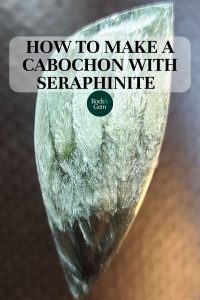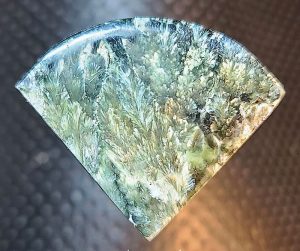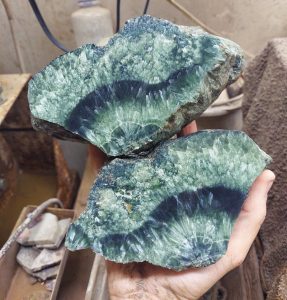
Seraphinite, also known as clinochlore or chlorite, is a type of this mineral. Only the Lake Baikal area of eastern Siberia is home to this mineral. Seraphinite got its name from Seraphims, the highest order of biblical angels. This is because it has a shimmering, feather-like look.
Seraphinite Properties
The inclusions of mica give the stone a wonderful chatoyancy. The inclusions are different sizes, and the longer ones have a feather-like appearance. Sometimes you will see shorter growth patterns arranged in rows, giving the appearance of a mystic forest. This stone is more sought-after for its radial growth pattern, which makes beautiful designs when cut into cabochons.
Find Seraphinite
It is still possible to buy seraphinite at shows or online, despite its rarity. Most of the time you can easily see what you’re getting, as the patterns will be quite visible on the outside. Pre-cut slabs are the best way to get a certain pattern and higher grade. You should be aware that this material can present some challenges if you are new to cutting seraphinite. It’s soft and can easily break in the trimming or cabbing process. It can also have varying hardnesses. This means that it can easily chip at the edges and tend to undercut.
 Cutting Patterns to Enhance their Beauty
Cutting Patterns to Enhance their Beauty
There is a general way to cut slabs when you first start. Usually, you’ll see radial or partially radial sprinklings at the bottom part of the stone. You will know what the top and bottom are, so that you may cut from north to southern for your slabs. The stone will have the most chatoyant patterns. Due to its softness, I recommend cutting the slabs a little bit thicker.
It will be less likely to break during the cabbing procedure. You will often get two distinct patterns once your slabs have been cut. The top part usually has tighter feather patterns. The bottom part will feature more radial patterns and longer feathery designs. The solid green sections will tend to be harder than the inclusions and undercut. The lighter color of the section, the more softer it is.
Cabbing Seraphinite
After your preforms have been trimmed and you are ready for cabbing, I recommend a different cabbing routine than cabbing agates or Jaspers. I start with a soft, 80-grit resin or steel wheel. This material is easy to remove. You can use a soft-touch to create your outside design. Next, you can move onto a 280-grit wheel or a 280-grit hard resin wheel to smooth out the edges on your cab and dome the top.
 The lighter the color the softer the material, so take care when attempting to cab thin or long cabs.
The lighter the color the softer the material, so take care when attempting to cab thin or long cabs.
After you finish shaping and doming your cab with the 280-grit sandpaper, dry it thoroughly. Make sure that you have removed any scratches at this stage. You can easily spot scratches if the mica inclusions are oriented in the same direction as the feathery sprays.
Start polishing the surface with the 600-grit sandpaper. Avoid applying too much pressure to the surface in order to avoid any unwanted undercutting. Then, move on to the 1200-grit wheel. Finish with either the 3k or 8k-grit wheel. This will leave you with a nice, glossy finish without the need for additional polishing compounds.
This story is about seraphinite Previous appeared You can also find out more about the following: Rock & Gem magazine. Click here to subscribe. Click here to subscribe. Russ Kaniuth
The post Seraphinite – What to Cut first appeared on Rock & Gem Magazine.
